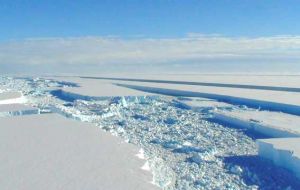MercoPress. South Atlantic News Agency
Large Antarctic glacier thinning four times faster than ten years ago
 Pine Island glacier in west Antarctica reveals the surface of the ice is now dropping at a rate of up to 16m a year.
Pine Island glacier in west Antarctica reveals the surface of the ice is now dropping at a rate of up to 16m a year. One of the largest glaciers in Antarctica is thinning four times faster than it was 10 years ago, according to research seen by the BBC. A study of satellite measurements of Pine Island glacier in west Antarctica reveals the surface of the ice is now dropping at a rate of up to 16m a year.
Since 1994, the glacier has lowered by as much as 90m, which has serious implications for sea-level rise. The work by British scientists appears in Geophysical Research Letters.
The team was led by Professor Duncan Wingham of University College London (UCL).
Calculations based on the rate of melting 15 years ago had suggested the glacier would last for 600 years. But the new data points to a lifespan for the vast ice stream of only another 100 years.
The rate of loss is fastest in the centre of the glacier and the concern is that if the process continues, the glacier may break up and start to affect the ice sheet further inland.
One of the authors, Professor Andrew Shepherd of Leeds University, said that the melting from the centre of the glacier would add about 3cm to global sea level.
“But the ice trapped behind it is about 20-30cm of sea level rise and as soon as we destabilise or remove the middle of the glacier we don't know really know what's going to happen to the ice behind it,” he told BBC News.
“This is unprecedented in this area of Antarctica. We've known that it's been out of balance for some time, but nothing in the natural world is lost at an accelerating exponential rate like this glacier.”
Pine Island glacier has been the subject of an intense research effort in recent years amid fears that its collapse could lead to a rapid disintegration of the West Antarctic ice sheet.
“Five years ago, I joined a flight by the Chilean Navy and Nasa to survey Pine Island glacier with radar and laser equipment.
“The 11-hour round-trip from Punta Arenas included a series of low-level passes over the massive ice stream which is 20 miles wide and in places more than one mile thick.
“Back then, the researchers on board were concerned at the speed of change they were detecting. This latest study of the satellite data will add to the alarm among polar specialists”.
This comes as scientists in the Arctic are finding evidence of dramatic change. Researchers on board a Greenpeace vessel have been studying the northwestern part of Greenland.
One of those taking part, Professor Jason Box of Ohio State University, has been surprised by how little sea ice they encountered in the Nares Strait between Greenland and Canada.
He has also set up time lapse cameras to monitor the massive Petermann glacier. Huge new cracks have been observed and it's expected that a major part of it could break off imminently.
Professor Box told BBC News: ”The science community has been surprised by how sensitive these large glaciers are to climate warming. First it was the glaciers in south Greenland and now as we move further north in Greenland we find retreat at major glaciers. It's like removing a cork from a bottle”.




Top Comments
Disclaimer & comment rulesCommenting for this story is now closed.
If you have a Facebook account, become a fan and comment on our Facebook Page!